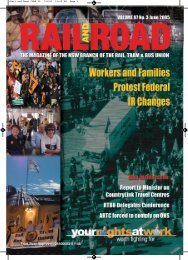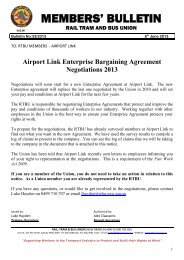Safety Matters - Rail, Tram and Bus Union of NSW
Safety Matters - Rail, Tram and Bus Union of NSW
Safety Matters - Rail, Tram and Bus Union of NSW
Create successful ePaper yourself
Turn your PDF publications into a flip-book with our unique Google optimized e-Paper software.
Dignity <strong>and</strong> respect in the workplace charter<br />
The <strong>NSW</strong> Government, in conjunction with public sector agencies <strong>and</strong> major<br />
public sector unions has developed the Dignity <strong>and</strong> Respect Policy, Model Code<br />
<strong>of</strong> Conduct <strong>and</strong> Workplace Charter, to ensure that their workplaces are free<br />
from all forms <strong>of</strong> bullying.<br />
Copies <strong>of</strong> the Dignity <strong>and</strong> respect: Policy <strong>and</strong> Guidelines on Preventing <strong>and</strong><br />
Managing Workplace Bullying <strong>and</strong> the Model Code <strong>of</strong> Conduct provide<br />
organisations with a framework to review <strong>and</strong> develop their own policies to<br />
eliminate bullying. Copies <strong>of</strong> these documents <strong>and</strong> the Dignity <strong>and</strong> Respect in<br />
the Workplace Charter are available from the OHS Resources section <strong>of</strong> the<br />
RTBU website, or from WorkCover.<br />
SECTION FOUR<br />
<strong>Safety</strong> <strong>Matters</strong> A Guide for Workplace OHS Representatives<br />
Develop a code <strong>of</strong> conduct for workplace behaviour<br />
A Code Of Conduct is a policy that outlines an organisation’s st<strong>and</strong>ards <strong>of</strong><br />
workplace behaviour <strong>and</strong> makes clear statements that all employees have<br />
Dignity <strong>and</strong> Respect at work <strong>and</strong> that bullying will not be tolerated. A N<br />
Model Code <strong>of</strong> Conduct for <strong>NSW</strong> Pubic Agencies has been developed, <strong>and</strong><br />
could usefully be modified to meet your organisation’s requirements.<br />
The policy can be developed on its own, or it may be included in relevant<br />
existing OHS policies.<br />
Another option could be to include it in a policy that covers workplace<br />
behaviour. Some organisations may want to include reference to occupational<br />
violence in their Code Of Conduct policy, instead <strong>of</strong> having a separate policy<br />
on this issue.<br />
When developing a Code Of Conduct policy the employer must consult with<br />
elected health <strong>and</strong> safety representatives. It is a good idea to also consult<br />
employees directly on the policy.<br />
An employer can create commitment to the Code Of Conduct policy by:<br />
• Developing a policy that is specific to the workplace<br />
• Consulting employees on the development <strong>of</strong> the policy <strong>and</strong> providing an<br />
opportunity to comment on a draft policy<br />
• Securing the commitment <strong>of</strong> the chief executive/employer to the policy <strong>and</strong><br />
involving them in policy development<br />
• Ensuring the policy is adhered to <strong>and</strong> consistently applied<br />
OHS Factsheets<br />
86<br />
RAIL<br />
TRAM AND BUS<br />
U N<br />
I O N

















